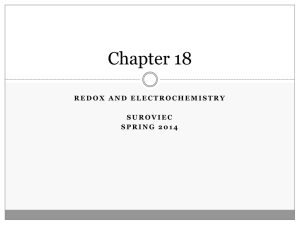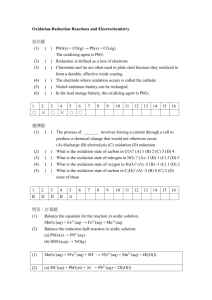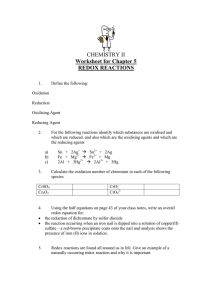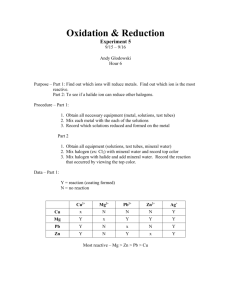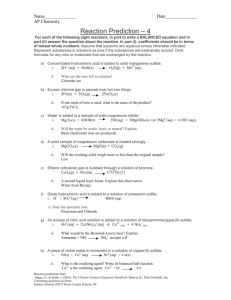Redox Reactions & Reactivity: Exam Questions
advertisement
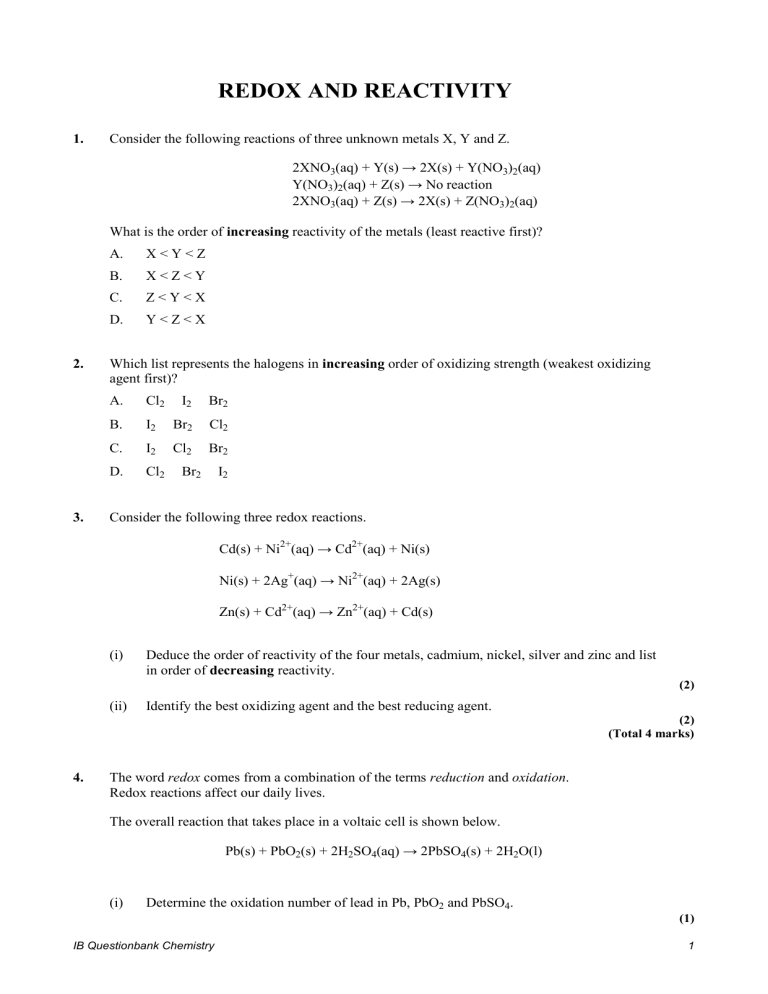
REDOX AND REACTIVITY 1. Consider the following reactions of three unknown metals X, Y and Z. 2XNO3(aq) + Y(s) → 2X(s) + Y(NO3)2(aq) Y(NO3)2(aq) + Z(s) → No reaction 2XNO3(aq) + Z(s) → 2X(s) + Z(NO3)2(aq) What is the order of increasing reactivity of the metals (least reactive first)? 2. 3. A. X<Y<Z B. X<Z<Y C. Z<Y<X D. Y<Z<X Which list represents the halogens in increasing order of oxidizing strength (weakest oxidizing agent first)? A. Cl2 I2 Br2 B. I2 Br2 Cl2 C. I2 Cl2 Br2 D. Cl2 Br2 I2 Consider the following three redox reactions. Cd(s) + Ni2+(aq) → Cd2+(aq) + Ni(s) Ni(s) + 2Ag+(aq) → Ni2+(aq) + 2Ag(s) Zn(s) + Cd2+(aq) → Zn2+(aq) + Cd(s) (i) Deduce the order of reactivity of the four metals, cadmium, nickel, silver and zinc and list in order of decreasing reactivity. (2) (ii) Identify the best oxidizing agent and the best reducing agent. (2) (Total 4 marks) 4. The word redox comes from a combination of the terms reduction and oxidation. Redox reactions affect our daily lives. The overall reaction that takes place in a voltaic cell is shown below. Pb(s) + PbO2(s) + 2H2SO4(aq) → 2PbSO4(s) + 2H2O(l) (i) Determine the oxidation number of lead in Pb, PbO2 and PbSO4. (1) IB Questionbank Chemistry 1 (ii) Deduce the oxidation and reduction half-equations taking place at the negative lead electrode (anode) and the positive lead(IV) oxide electrode (cathode). Deduce the oxidizing and reducing agents and state the direction of the electron flow between the electrodes. (4) (iii) In order to determine the position of three metals in a reactivity series, the metals were placed in different solutions of metal ions. The table below summarizes whether or not a reaction occurred. Ag+(aq) Ag(s) Cu(s) Reaction Pb(s) Reaction Cu2+(aq) Pb2+(aq) No reaction No reaction No reaction Reaction State the equations for the three reactions that take place. Use this information to place the metals Ag, Cu and Pb in a reactivity series, with the strongest reducing agent first, and explain your reasoning. (5) (Total 10 marks) ANSWERS 1. B 3. 2. B (i) (ii) Zn > Cd > Ni > Ag Zn most reactive; rest of order correct; 2 Best oxidizing agent: Ag+; Do not accept Ag. Best reducing agent: Zn; Do not accept Zn2+. 2 [4] 4. (i) (ii) Pb: 0, PbO2: +4, PbSO4: +2; Need sign for mark. Do not accept notations such as 4+, 2+ or IV, II. 1 Negative/–/anode Pb(s) + SO42–(aq) → PbSO4(s) + 2e– / Pb(s) → Pb2+(aq) + 2e–; Positive/+/cathode PbO2(s) + 4H+(aq) + SO42–(aq) + 2e– → PbSO4(s) + 2H2O(l) / PbO2(s) + 4H+(aq) + 2e– → Pb2+(aq) + 2H2O(l) / PbO2(s) + H2SO4(aq) + 2H+(aq) + 2e– → PbSO4(s) + 2H2O(l); Accept Pb4+ + 2e– → Pb2+. Ignore state symbols. Allow e instead of e–. oxidizing agent is PbO2 / lead(IV) oxide/lead dioxide and reducing agent IB Questionbank Chemistry 2 is Pb/lead; from negative/–/anode/Pb to positive/+/cathode/PbO2 (through the external circuit/wire); (iii) 4 Pb(s) + Cu2+(aq) → Pb2+(aq) + Cu(s) Pb(s) + 2Ag+(aq) → Pb2+(aq) + 2Ag(s) Cu(s) + 2Ag+(aq) → Cu2+(aq) + 2Ag(s) Award [2] for three correct, award [1] for any two correct, one correct scores no mark. Ignore state symbols. Penalize unbalanced equations once only. Pb is a stronger reducing agent than Cu and/or Ag / Pb most reactive as it + can reduce/displace both Cu2+ ; Cu is a stronger reducing agent than Ag but not Pb / Cu in the middle (of the 2+ three) as it can reduce/displace Ag+ ; Accept converse argument. Decreasing order: Pb, Cu, Ag / Pb > Cu > Ag; Do not accept: Pb2+, Cu2+, Ag+. 5 [10] IB Questionbank Chemistry 3
